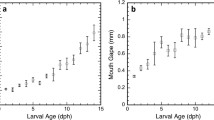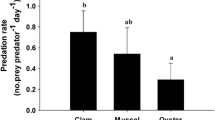Abstract
Capture success of the medusa Aurelia aurita preying on various developmental stages of fish larvae was measured together with larval reactivity and escape speed after being stung. These experiments were conducted in the spring of 1983 with A. aurita medusae collected from Loch Etive, Scotland and laboratory-reared larvae of Gadus morhua L., Platichthys flesus L., Pleuronectes platessa L. and Clupea harengus L. Capture success of the medusae increased with medusa size, but decreased with advancing larval development. Smaller species of larvae were more vulnerable to capture. Larval reactivity to encounters with medusae increased with advancing development, and larger species of larvae were more reactive to encounters. Larval escape swimming speeds also increased with advancing larval development and size. These results indicate that earlier stages of larvae within a species and smaller species of larvae at a given stage are more vulnerable to predation by medusae since they are less reactive to encounters. Apparently they are more susceptible to the effects of neurotoxins. Predation rates on different developmental stages of herring larvae are documented and compared with rates predicted by a predation model. Predictions fell within the range of observed predation rates, but tended to overestimate rates by larger medusae feeding on larger herring larvae. This indicates the possibility of predator satiation and/or behavioural avoidance.
Similar content being viewed by others
Literature cited
Bailey, K. M.: Comparison of laboratory rates of predation on five species of marine fish larvae by three planktonic invertebrates: effects of larval size on vulnerability. Mar. Biol. 79, 303–309 (1984)
Bailey, K. M. and R. S. Batty: A laboratory study of predation by Aurelia aurita on larval herring (Clupea harengus): experimental observations compared with model predictions. Mar. Biol. 72, 295–301 (1983)
Batty, R. S.: Observations of fish larvae in the dark with television and infra-red illumination. Mar. Biol. 76, 105–107 (1983)
Lillelund, K. and R. Lasker: Laboratory studies of predation by marine copepods on fish larvae. Fish. Bull. U.S. 69, 655–667 (1971)
Möller, H.: Scyphomedusae as predators and food competitors of larval fish. Meeresforsch. Rep. mar. Res. 28, 90–100 (1980) (Ber. dt. wiss. Kommn Meeresforsch.)
Möller, H.: Reduction of a larval herring population by jellyfish predator. Science, N.Y. 224, 621–622 (1984)
Theilacker, G. and R. Lasker: Laboratory studies of predation by euphausiid shrimps on fish larvae. In: The early life history of fish, pp 287–299. Ed. by J. H. S. Blaxter. Berlin: Springer-Verlag 1974
Webb, P. W.: Responses of northern anchovy larvae, Engraulis mordax, larvae to predation by a biting planktivore, Amphiprion percula. Fish. Bull. U.S. 79, 727–735 (1981)
Author information
Authors and Affiliations
Additional information
Communicated by J. Mauchline, Oban
Rights and permissions
About this article
Cite this article
Bailey, K.M., Batty, R.S. Laboratory study of predation by Aurelia aurita on larvae of cod, flounder, plaice and herring: development and vulnerability to capture. Mar. Biol. 83, 287–291 (1984). https://doi.org/10.1007/BF00397461
Accepted:
Issue Date:
DOI: https://doi.org/10.1007/BF00397461




